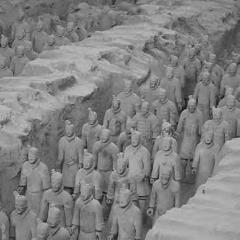Located in Xian, China, in Shaangxi Province, which was once the capital of the Chinese Empire for 13 dynasties, the Terracotta Army is one of the great archaeological finds of the twentieth century. It was discovered by two farmers who were drilling for water in 1974. In the third century B.C.E., the very first emperor of China, Qin Shi Huang, united China, established the longest-running form of government, built the Great Wall, and built his own elaborate tomb. As a symbol of his rule and to guard himself in the afterlife, Qin Shi Huang had an entire army replicated—approximately 8,000 soldiers, 130 chariots with 520 horses, and 15 cavalry horses, all life size and each with distinct facial expressions—to guard the first emperor’s mausoleum at Mt. Li in Xi’an, China.

The Terracotta Army, created in the third century B.C.E., was discovered buried near Xian, China (image courtesy of Maros Mraz/GNU free documentation license).

